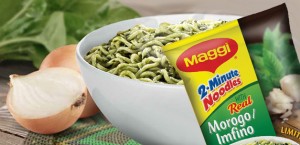Reviving South Africa’s Love For Morogo

‘Morogo’ or ‘South African spinach’ refers to different varieties of green leafy vegetable that grow wild in South Africa, and a popular dish of the same name. Traditionally, these vegetables formed a much-loved part of the nation’s diet, but urbanisation and changing attitudes to food in the countryside have led to a decline in their popularity.
Much as Europeans have traditionally foraged for mushrooms, generations of South Africans have gathered morogo (which is high in protein, vitamins and minerals), to fry, boil or steam, and serve with onions or tomatoes.
In its new format, morogo is causing a stir on South African supermarket shelves. Until today it has never been farmed on a serious commercial scale, but now Nestlé is using morogo in the ‘tastemaker’ sachet used to flavour and fortify its Maggi noodles.
“Many packaged food brands claim to cater for local tastes, but Maggi with morogo genuinely does so. We’re offering people an authentic taste of South Africa and bringing a nutritious ingredient to urban dwellers, in particular, through a product that is quick and easy to prepare,” says Maarit Rein, a scientist working at Nestlé Research Center in Lausanne, Switzerland.
The new Nestlé noodles developed out of a partnership with South Africa’s Council for Scientific Investigation and Research (CSIR) and Agricultural Research Council (ARC) from 2012, to research plants growing there with clear health benefits, for potential use in foods to improve the nation’s diet.
Taste, nutritional quality and abundance were three things that the scientists were looking for in an ingredient. It had to be possible to process it for use in a food product, and it was vital that the ingredient provide farmers with an income source. Crucially, it also had to appeal to millions of South Africans.
 Nestlé and its partners decided to research three species of morogo – amaranthus, cow pea and cleome – and worked closely with farmers to perfect their cultivation, and to refine the plants into a powder that preserved their nutritional benefits.
Nestlé and its partners decided to research three species of morogo – amaranthus, cow pea and cleome – and worked closely with farmers to perfect their cultivation, and to refine the plants into a powder that preserved their nutritional benefits.
Getting a robot to eat its greens doesn’t seem the most obvious way to assess morogo’s nutritional potential, but this is exactly what the team did. Maarit Rein explains how they used an ‘artificial gut’ to compare the three varieties.
“An artificial gut is like a robot with a stomach and digestive tubes,” Maarit Rein says. “It allowed us to measure the quantities of different nutrients released from morogo during digestion, to assess their ‘bioavailability’ – their capacity to be absorbed into the bloodstream.”
Following this work the scientists chose amaranthus as the winning variety of morogo, due to its high levels of beta carotene, minerals and protein in particular.

































